In Britain I was very good at knowing my wildflowers. If you had stuck me in the middle of a meadow or woodland I could have told what you could and couldn’t eat. Move to Turkey and I am slightly lost. Common Turkish herbs are easy, as is fruit. It’s everything in between.
Flowers for tea?
This was highlighted to me when my friend’s son came home with a bunch of flowers that he was eating! Neither of us knew what they were but his headmaster had told him they were fine to eat. Hmm, I needed to do some research. A lot of this list is from the Turkish Cuisine Portal. A brilliant website that has loads of information. The other way is to ask people. Visit the villages and markets. People love to share knowledge.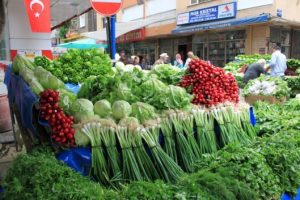
Anywhere you look in a country with such natural diversity as Turkey, you can become acquainted with plant you’ve never seen before. Go to the market and you will see plenty of bunches of wild greens. The gozleme you ate might have been made with wild plants weeded a garden or gathered along the roadside and will have been the tastiest thing you tried on holiday.
There are thousands of plant species in Turkey. Many are edible, and many are endemic, meaning that they grow only in Turkey. Some of these may be familiar to you. Nettles, mallow, sage, rosemary and thyme.
It would be impossible to list everything in Turkey that you can eat. Regions vary from each other as well as habitats.
As always, please BE CAREFUL. If you don’t know what you are picking, ask someone. People will be very informative and willing to help you.
Turkish Herbs
Arapsaçı (Fennel, Foeniculum vulgare): This “anise” scented herb looks like dill at first glance, but its flavour and aroma are completely different. Its seeds, leaves, stems and roots are used. In the same family as carrots and parsley, fennel grows in northern Anatolia as well as the Aegean and Mediterranean regions. Its tender shoots, buds and leaves are used in cooking. According to immigrants from Crete, it is best cooked with lamb, while in the Aegean and Mediterranean it is used in sautés of mixed greens, and in böreks. It is also used with fish and other meat dishes, and goes well with legumes.
Bambul (Bittersweet, Solanum nigrum): This herb, found in markets in the Aegean region during the summer, is called istifno (stifnos) in Ayvalık. In the same family as tomatoes, it is an annual with small white flowers and tiny red fruits. It is lightly aromatic and has a slightly bitter flavour. Some related species have poisonous fruits, like Deadly Nightshade. It is boiled together with zucchini or alone as greens, cooked like spinach.
Çiğdem (Crocus, Crocus): With over forty different species occurring naturally in Anatolia, crocus is one of the harbingers of spring. Their roots contain starch and sugar, and can be eaten raw or cooked in savory dishes as well as sweets. The best-known dishes are crocus stew, crocus pilaf and crocus with milk (a dessert). It is also cooked plain on coals. In the Black Sea region, it is rolled in flour and fried.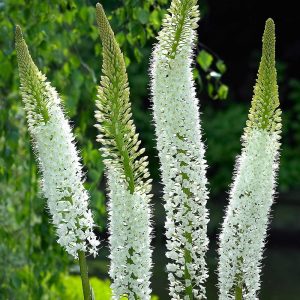
Çiriş (Foxtail Lily, Eremurus spectabilis). The çiriş which shows up in the markets of Istanbul in April are the leaves of a plant in the lily family with hundreds of yellow flowers. It grows in the mountains of Eastern and Southeastern Anatolia as well as Central Anatolia. It is most commonly made into pilaf and cooked with eggs. In Sivas it is cooked together with sorrel and is delicious. In Bingöl it is used in soup.
Deniz Börülcesi (Samphire or Glasswort, Salicornia europea): Glasswort, with its salty, succulent knotted stems, grows in saline environments. If its roots are not pulled up when collecting it, it can live for years. In Turkey, glasswort is best known in the Aegean region, but recently it has come into vogue in fish restaurants for its elegant appearance and unique flavour. It is mostly simmered and served cold with lemon and oil, but it goes well with all types of seafood.
Ebegümeci (Mallow, Malva sylvestris): Pink flowered mallow, which grows almost everywhere in Turkey, prefers dry and sunny areas. It is used in a wide variety of dishes. It’s large leaves are made into sarma, (stuffed leaves, usually with minced meat) everyone loves it cooked with rice; it also finds its way into börek fillings and sautés. Its tender young leaves are boiled and served cold with yogurt, and are also eaten raw in salads after being lightly kneaded with salt. In Central Anatolia it is cooked with meat as well as with okra. In Adana, a mallow salad with pomegranate molasses is common.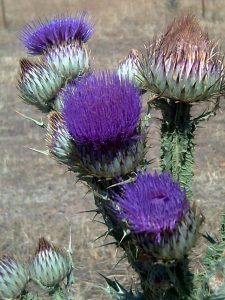
Eşek Dikeni (Illyrian thistle, Onopordum illyricum): This wickedly thorny plant with striking, large pink-violet flowers is common throughout Western Anatolia, growing in tall, upright stands along roadsides. Inland it is less common but does occur in some areas. Under the formidable thorns are tender stems which are cooked and served with an egg lemon sauce, or with lemon and olive oil.
Eşek Marulu (Wild Lettuce, Sonchus oleraceus): This biennial plant has a rosette the first year, and the second year grows up to bloom with long, lightly veined, medium green toothed leaves. When the crisp stems are cooked, they retain their crunchiness and are delicious served with olive oil and lemon. It can also be used in sautés and in börek. It is sometimes cooked with eggs, with ground meat, or cooked in either bulgur or rice pilaf.
Gelincik (Corn Poppy, Papaver rhoeas): Cousin to the more (in)famous opium poppy, Corn poppy is a more delicate, slightly fuzzy plant with brilliant red flowers. It is common in spring in both wild and cultivated fields. It likes moist and rich soils. Its greens go very well with legumes, and can be combined with lentils or black-eyed peas, added to sautés, cooked with bulgur or used to fill various böreks. It is gathered before the flower buds form, and can be used any way chard can. Of course, the brilliant red syrup made from its flowers must also not be forgotten. In Bursa, this syrup was once used to lend colour to white milk puddings.
Hardalotu (Wild Mustard, Sinapis arvensis): An herbaceous plant with yellow flowers, wild mustard grows in many locations in Turkey. With a slightly bitter flavour and mustard aroma, it is very popular in many regions. It has slightly fuzzy stems and dark green leaves. Because of its bitter flavour, it is parboiled first and then drained, and is generally served as a traditional Aegean “boiled salad,” with olive oil and lemon. It can also be sautéed without parboiling and mixed with eggs. In Denizli it is used to fill sac böreği, in İcel, it is cooked with bulgur and in Adana, with ground meat.
Hindiba (Wild chicory, Cichorium intybus): Although the spring leaves resemble those of dandelion, the branching plant and blue flowers set it apart. The beautiful blue flowers may occur singly or in groups, and open only in the morning. Its roots may be roasted and ground as a coffee substitute, while the buds are made into pickles. It may be added to kavurma with mushrooms, borani, potato salad, or made into köfte, and its tender leaves may be added to salads.
Hodan (Borage, Borago officinalis): An herbaceous plant with succulent stems, thick wrinkled and hairy leaves, and flowers that open pink and mature to a deep blue. Borage is most often sautéed with eggs; ask any seller at the market and that is the recipe he’ll give you. But it also may be cooked with meat or chicken, or made into börek.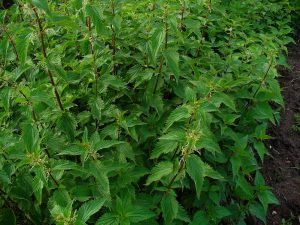
Isırgan (Stinging Nettle, Urtica dioica): A somewhat weedy plant that doesn’t take kindly to handling. Stinging nettle grows in many different soil types and in every region of the country. It is the young branches and especially the upper shoots that are used in food. These may be made into soup, salad, börek, köfte and other dishes. It is often used in mixed green dishes, and bulgur or rice pilaf with nettles is one of our very popular dishes. In the Black Sea region, a corn meal soup with nettles is made, and in the Aegean region, it is a main ingredient in böreks.
Işkın (Wild Rhubarb, Rheum ribes): A wild relative of the rhubarb used in Europe and America. This plant is distinct with its mostly green, very rough stems. Its sour, astringent leaf stems are collected during the spring in the mountains of Eastern Anatolia, where they are both eaten raw as a snack and cooked in a variety of dishes. One example is eggs with ışkın and kapuska.
İğnelik (Cranesbill, Erodium and Geranium spp): Named for its long, pointed seed heads, cranesbill catches our eye in the spring with its lovely pink flowers along the roadsides. The leaves have a strong aroma and for this reason I used it in moderation or mixed with other vegetables. It can be added to börek fillings or bulgur pilaf, or cooked with eggs as well.
Karahindiba (Dandelion, Taraxacum türleri): Dandelion appears in the spring with bright yellow flowers. With either toothed or entire green leaves and a bitter flavour, it grows throughout Turkey. Although the tender new shoots are edible raw, they become bitter when mature and must be boiled. It can then be served with olive oil and lemon, or with tarator (yoghurt soup). If you like, you can use it to add flavour to a salad of onion, tomatoes, other wild herbs and boiled potatoes.
Kaya Koruğu (Rock Samphire, Crithmum maritimum): If you find yourself in a rocky area along the seashore where the sea water wets the rocks, look for plant with thick, succulent finely divided leaves. Especially common on the Aegean and Mediterranean coasts, Rock Samphire, with its iodine-like scent, is an herb you will either love or hate. Its tender leaves and stems are made into a pickle in the same way as capers. In some areas, its leaves, flowers and stems are cooked in omelettes, and it also makes a good salad with yogurt.
Kazayağı (Sicle Weed, Falcaria vulgaris): Sicle weed is a spreading plant reminiscent of parsley, with pinkish stems. Although in some areas the tender new leaves are eaten raw, it is usually cooked. In the Aegean, it is cooked alone or along with other herbs. It can be added to böreks, to bulgur or rice pilafs and to meat dishes. It can also be simmered, then mixed with yogurt and garlic.
Kenker (No English common name, Gundelia tournefortii): Kenker is a spiny plant up to a meter high, with a milky juice. Its tender shoots are eaten after the spines are removed; the root yields a sort of local chewing gum. In Eastern Anatolia, where it is a very popular food plant, one can find a host of recipes for it. In the old days, Kenker was used to curdle milk for cheese. Its root, stems and seeds are edible; it is also pickled.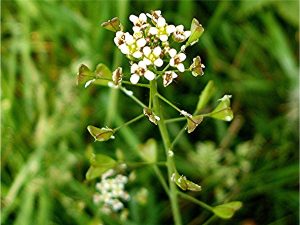
Kuş Ekmeği (Shepherd’s Purse, Capsella Bursa-pastoris): This plant has a rosette of broad leaves close to the ground and an ascending stem with flowers and seeds from 40-50 cm at the most. The tender shoots can be eaten raw but it is usually cooked with other herbs, or lightly boiled and made into a salad. It is also put into soup, meat dishes, bulgur or rice pilaf. It also has medicinal properties.
Kuş Otu (Chickweed, Stellaria media): This plant has small tender leaves and tiny white flowers. In spring, it is very common in the markets. It is edible raw, but also is cooked like spinach and purslane, and is put into böreks.
Kuş Yüreği (Dog’s Cabbage, Theligonum cynocrambe): This herb with small heart-shaped leaves is sure to show up in the markets of Bodrum during the winter. It is one of the first herbs to emerge following fall rains, and makes a good salad. Its Turkish name means “bird’s heart,” due to the shape of its leaves. It is used in börek, and can be cooked like spinach. In Muğla, it is indispensable in wild green sautés.
Kuzukulağı (Sorrel, Rumex acetosella): This herb has long narrow leaves with pink stems. It flavour is more sour than lemon. Sorrel likes shady, cool places, and is much used in salads for its tart flavour. It also is used in soups and mixtures of herbs for börek, and cooked with rice. In Samsun, it is used in a dish with black-eyed peas; in Adana as a salad and in Gebze, is cooked together with fennel and dock. If you are looking for a tart flavour for your cooking and salads, sorrel is just the thing during its season.
Labada (Dock, Rumex): In the buckwheat family, dock is a relative, one might say a close cousin, to sorrel. They resemble each other but dock has a much firmer leaf and is not sour like sorrel. One of the most-made sarmas in Central Anatolia is from dock leaves. Because it grows nearly everywhere and is easy to find, it shows up in pilafs, is made into soup, and cooked in other dishes. In Eastern Anatolia, it is also sold in its dry form.
Madımak (Knotweed, Polygonum cognatum): One of the most commonly used herbs in Anatolia, madımak is considered one of the signs of spring’s arrival. It is a low, spreading herb with elliptical dark green leaves and hard stems. It is made into soup, and cooked with eggs, in pilaf, with pastırma and made into cacık. In some Anatolian villages, it is wrapped in yufka (a type of soft pancake, wrap) and eaten raw. Dried and stored for winter, it is made into pide and cooked with milk.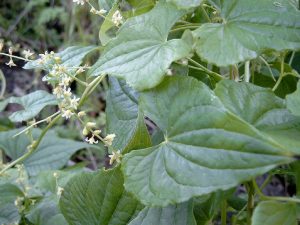
Sarmaşık (Black Bryony, Tamus communis): Also, known as acı filiz (bitter shoot) because of its bitter taste, black bryony is much loved in the Aegean region and is believed to be medicinal. The plant is poisonous but the new copper-coloured shoots and first leaves are edible when cooked well, and have been eaten since antiquity. The young stems are cooked with scallions and olive oil, and then eggs are added, or cooked alone. Immigrants from Crete make it into a meze with béchamel sauce.
Semizotu (Purslane, Portulaca oleracea): Wild purslane has small, slightly glaucous leaves and white or yellow tiny flowers. There are six wild species in Turkey, which are used either fresh, or dried in Central and Southeastern Anatolia. It is added raw to salads, served with yogurt or tomatoes and onions. In Maraş it is made into soup, in Gaziantep it is commonly cooked with legumes, in Kilis it is sautéed with ground meat and in Central Anatolıa is cooked with rice in various ways. Purslane stems can be pickled, and its seeds ground and added to flour.
Silcan (Greenbriar, Smilax türleri): Known as dikenucu in the Black Sea region, silcan is a strongly vining plant with heart shaped leaves and thorny stems. The edible portion is the tender 5-10 cm end shoots. A specialty of Tirebolu is dikenucu pickles. In Cide, it is cooked with eggs; if it is to be put into börek it is sautéed with onion and oil.
Sirken (Chenopodium): There are several different species of Chenopodium known by different English names, such as Fat-hen, Wormseed and Good King Henry. Its leaves are wavy edged, some long and some broader; its flowers resemble clusters of grapes. It is cooked with meat, bulgur, or served with yogurt, and of course finds its way into böreks as well. In the Antalya region, it is made into a börek with peas and ground meat, while in Samsun it is made into a sort of mücver ( a courgette fritter).
Su Kazayağı (Lesser Water Parsnip, Sium sisarum): This plant, which favours wet places, is also known as yabani kereviz (wild celery). A member of the parsley family, with pointed wide edged, smooth leaves distributed equally on both sides of the stem. It has umbels of white flowers. Can be used anywhere celery/celeriac leaves are used. Around Bodrum-Muğla, it is both sautéed as well cooked with bulgur. Its leaves and stems are good in omelettes and meat dishes, and can be put into böreks.
Su Teresi (Watercress, Nasturtium officinale): Usable everywhere normal garden cress is used, this is a water-loving plant with small white flowers. Its heart-shaped leaflets are evenly distributed on the ends of the stems. It spreads by sending new shoots form the bases of the stems which emerge on either side of the thick but tender main stems. Can be used in salads and soups, in mixtures of herbs for böreks and can be sautéed with other herbs. It goes very well with potatoes.
Şevketi Bostan (Golden Thistle, Scolymus hispanicus): This yellow flowered, thorny biennial plant grows at elevations of up to 1,600m. It grows commonly throughout Anatolia. The rosettes that emerge in early spring are edible. In Crete, it is pickled, it roots are fried and eaten with eggs. It is also simmered or grilled and eaten with olive oil and vinegar (or lemon) as a salad. In the Aegean region it is general cooked with meat or with chickpeas.
Teke Sakalı (Salsify or Goatsbeard, Scorzonera veya Tragopogon):Before it flowers, these plants grow up with stringy leaves in fields and along roadsides. Their majestic white, yellow or pink flowers are quite striking. In the Aegean region it is mostly used in böreks; in the markets it is often sold as “börek herb.” In Ankara it is made into cacık, combined with spices and cucumbers. It can be sautéed alone or with eggs, and eaten with garlic yogurt.
Turp Otu (Wild Radish, Raphanus raphanistrum): Like its cousin, mustard, this plant with its radish-scented leaves grows in orchards, along roadsides and in fields. It has white or light yellow flowers. Wild radish is mostly cooked and served with olive oil and lemon as a salad. In Bodrum, after cooking, it is mixed with eggs and fried. In Aydın, it is boiled, then sautéed with onions, and also made into a salad with pomegranate molasses, while in Izmir, lemon is used.
Yabani Kuşkonmaz (Wild Asparagus, Asparagus acutifolius): Wild asparagus is a semi-vining bushy plant in the lily family. Its long, whippy shoots emerge from the base of the plant or directly from the ground. Very attractive with their dark green or reddish purple colour. In the Aegean, the favourite way of cooking is sautéing with eggs. Used in a wide variety of recipes, from pasta sauces to quiches and soups, anywhere cultivates asparagus would be used.
Yabani Pazı (Wild Chard, Beta vulgaris): A member of the spinach family, wild chard can grow up to one meter in height. Its leaves resemble those of common swiss chard but are smooth with red stems. Its flowers, which emerge the second year, are pale greenish yellow. In Kerkük, Iraq, sarma are made from the leaves of pazı, and you will find it in the bazaars of the Aegean region, destined for börek and sautees. In the Black Sea it is used in soup. Also served like spinach, served as a salad after boiling, or cooked with legumes.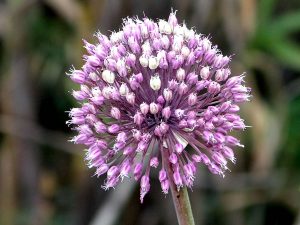
Yabani Sarımsak (Wild garlic, Allium): Wild garlic resembles cultivated garlic. Its flowers range from white to pink, and appear in a ball at the end of a long thin stem. The various species may be think or thick stemmed. Use in soups, omelets, sautees, börek and other dishes, breads, pasta sauces and cheese. As with regular garlic, it may be used either fresh and green or in bulb form. Called “sirmo” in the East, it is the vital ingredient in the famous herbed cheese from Van and its surroundings.

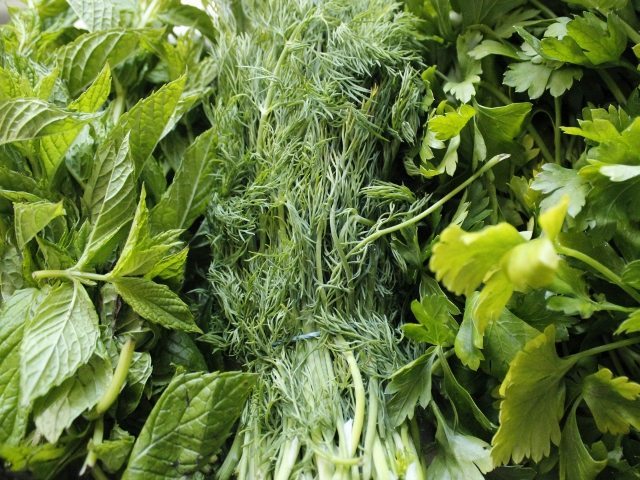
Comments